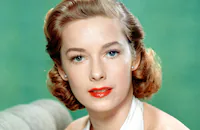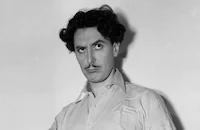Back Street

Brief Synopsis
Cast & Crew
David Miller
Susan Hayward
John Gavin
Vera Miles
Charles Drake
Virginia Grey
Film Details
Technical Specs

Synopsis
Following his discharge from the Marines after World War II, Paul Saxon, heir to a chain of department stores, has an affair with Rae Smith, the owner of a dress shop in Lincoln, Nebraska. However, when Rae learns that Paul is married and has two children, she moves to New York and becomes a successful fashion designer. Paul finds her there, but Rae refuses to become the "other woman" in his life. Years later they meet again in Rome, where Rae, now the partner of the celebrated designer Dalian, has opened a salon. During the 3 days they spend together at Rae's seaside villa, Paul explains to Rae that his alcoholic wife, Liz, refuses to grant him a divorce. After a suicide attempt by Liz, Paul buys Rae a house in the Paris suburbs, and the two lovers continue to meet. Eventually Paul's young son identifies Rae as the mysterious woman in his father's life and orders her to stay away. Then Liz publicly shames Rae during one of her fashion shows. That same night, while driving with Paul, the drunken Liz loses control of the car and is killed in a crash. Paul is taken to a hospital and calls Rae to profess his love before he dies. Later, Rae is visited by Paul's two orphaned children, who now share with her a common bond of loneliness and grief.

Director

David Miller
Cast

Susan Hayward

John Gavin

Vera Miles

Charles Drake

Virginia Grey

Reginald Gardiner
Tammy Marihugh
Robert Eyer
Natalie Schafer
Doreen Mclean
Alex Gerry
Karen Norris
Hayden Rorke
Mary Lawrence
Joe Cronin
Ted Thorpe
Joseph Mell
Dick Kallman

Joyce Meadows
Lilyan Chauvin
Joanne Betay
Vivianne Porte
Isabelle Felder
Melissa Weston
Bea Ammidown
Crew
Phil Bowles
Howard Bristol
Milton Carruth
Leon Charles
Stanley Cortez
Ken Darby
Larry Germain
Joseph Gershenson
Alexander Golitzen
Eleanore Griffin
Alison Hunter
Ross Hunter
Lew Leary
Jean Louis
William Ludwig
Frank Skinner
Frank Skinner
Waldon O. Watson
James Welch
Bud Westmore
Frank H. Wilkinson

Photo Collections
Videos
Movie Clip




Hosted Intro
Film Details
Technical Specs

Award Nominations
Best Costume Design
Articles
Back Street (1961)
Things were improving for Hayward on the home front, too. She'd married Floyd Eaton Chalkley, a "shrewd businessman," as she described him, "a horse-trader, as they might say in the South." He was magnanimous where Hayward was emotionally cautious, and gestures like sending four dozen roses to the set for their anniversary did much to melt her heart. Still, no matter how serene her romantic life, Hayward still had to deal with spiteful stunts from her sister, like the article in the May 1961 issue of Confidential with this tattletale headline: "My sister Susan Hayward has millions - BUT I'M ON RELIEF". Maybe that's why "women's picture" impresario Ross Hunter chose Hayward for the lead in the third retelling of Fannie Hurst's adultery parable Back Street (1961). The milky-skinned redhead from Flatbush, NY knew what it was like to live in the shadow of another, more beloved woman.
Like the movies based on Fannie Hurst's other novel Imitation of Life, Back Street was ripe fodder for remakes - once in 1932 with John Boles and Irene Dunne, and in 1941 with Margaret Sullavan and Charles Boyer. Those editions focused more on the painful reality of being a woman in love with a married man. But Hunter, who'd made his name with extravagant melodramas like Magnificent Obsession (1954) and rom-com confections like Pillow Talk (1959), freely admitted "I don't want to hold a mirror up to life as it is." His rendition of Back Street included scenes in New York, Paris and Rome, luxurious sets designed by his life partner Jacques Mapes, and $112,000 worth of Jean Louis gowns for Hayward. Whatever reservations she had about the script were overcome by these perks, and she willingly lost 15 pounds on a liquid diet before shooting began.
To round out the cast, Hunter selected John Gavin to play opposite Hayward - an unusual choice, since the swarthy Gavin was 30 years old to Hayward's 44, and towered over her by a foot. But Gavin was being groomed by Universal as a secondary version of Rock Hudson (also a Universal contract player). Since Hunter had previously produced seven features with Hudson, a stint under him may have been part of Gavin's tutelage. Hunter also cast Vera Miles, Gavin's co-star in the previous year's Psycho (1960), as the wife in the middle of this ill-fated love triangle. Miles was mousy in an overcoat the last time she and Gavin appeared on screen together, but here she flexes her considerable sex appeal as the evil, alcoholic shrew who won't take her hooks out of Hayward's lover.
Back Street premiered in October 1961 and was an immediate box office hit, even though the critics weren't impressed. The New York Times dismissed it as "a moral and emotional fraud" and Time magazine commented on how Hayward's well-heeled character isn't as tortured by her romantic frustrations as in the movie's previous incarnations: "She still suffers, but on silk."
To audiences, none of that mattered. They responded to something genuine in Hayward's performance, in how her eyes light up in every scene with Gavin and how she surrenders ecstatically to a clinch in the grass or brightens at the sound of her lover's voice on the phone. Hayward may have had a reputation for being frosty and remote in real life (three-time co-star Robert Preston once remarked "Anything I have to say about Susan Hayward you couldn't print"), but in every frame of Back Street she exudes a vulnerable, palpable joy. Biographers Robert LaGuardia and Gene Arceri hypothesized in their book Red: The Tempestuous Life of Susan Hayward that the "glow of love in Susan's face" in this movie is because of the emotional peace she'd found with Chalkley. "She did very little real acting in the movie . . . what she did was play the part of herself that was in love."
Producer: Ross Hunter
Director: David Miller
Screenplay: Eleanore Griffin, William Ludwig (screenplay); Fannie Hurst (novel)
Cinematography: Stanley Cortez
Art Direction: Alexander Golitzen
Music: Frank Skinner
Film Editing: Milton Carruth
Cast: Susan Hayward (Rae Smith), John Gavin (Paul Saxon), Vera Miles (Liz Saxon), Charles Drake (Curt Stanton), Virginia Grey (Janey nee Smith), Reginald Gardiner (Dalian), Tammy Marihugh (Caroline), Robert Eyer (Paul Saxon Jr.), Natalie Schafer (Mrs. Evans), Doreen McLean (Miss Hatfield).
C-107m.
by Violet LeVoit
References:
Obituary of Ross Hunter
http://www.independent.co.uk/news/obituaries/obituary-ross-hunter-1341764.html
Holston, Kim R.Susan Hayward: Her Films And Life.
LaGuardia, Robert and Gene ArceriRed: The Tempestuous Life Of Susan Hayward.
Linet, Beverly.Susan Hayward: Portrait Of A Survivor

Back Street (1961)
Quotes
Trivia
Notes
Previously filmed in 1932 and 1941.

Miscellaneous Notes
Released in United States Summer August 20, 1961
This was the third adaptation of this story, following 1932 and 1941 versions.
Released in United States Summer August 20, 1961














